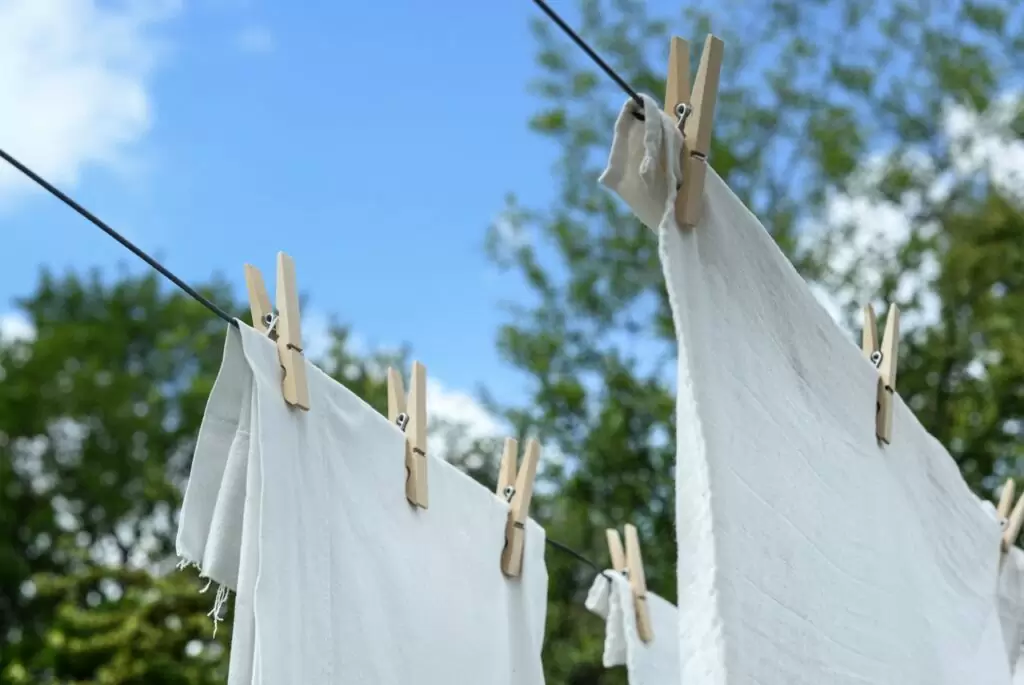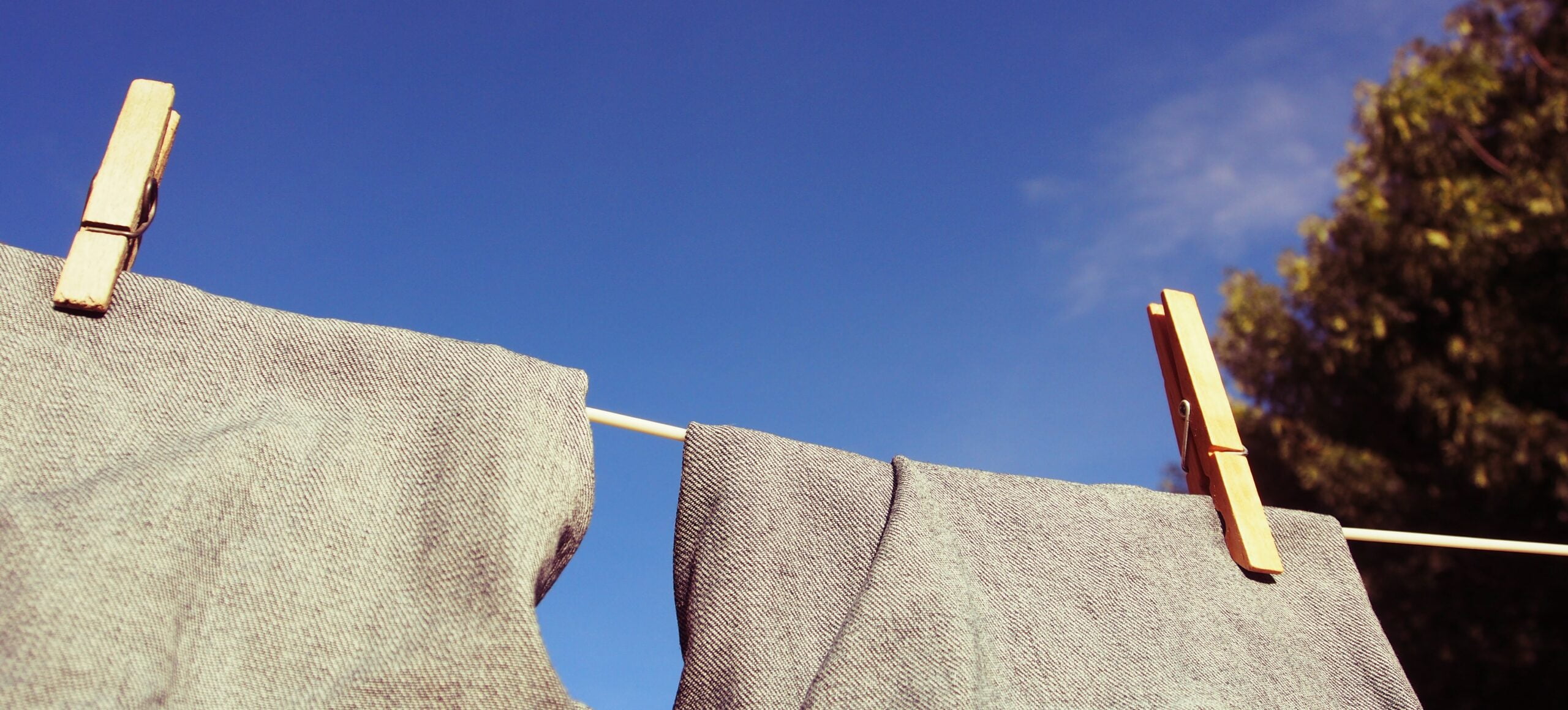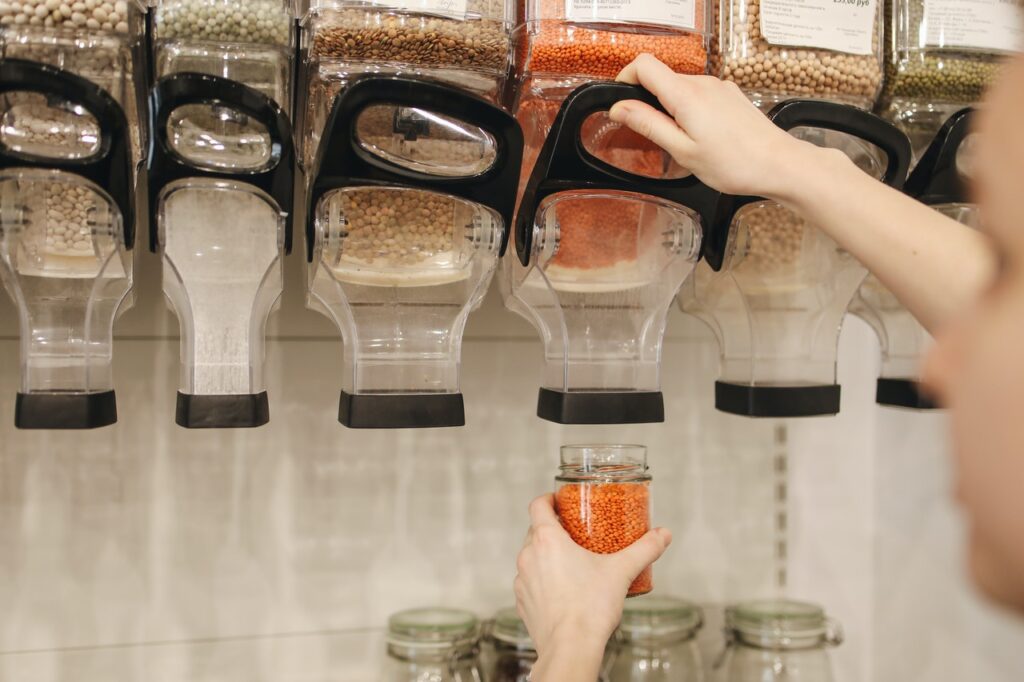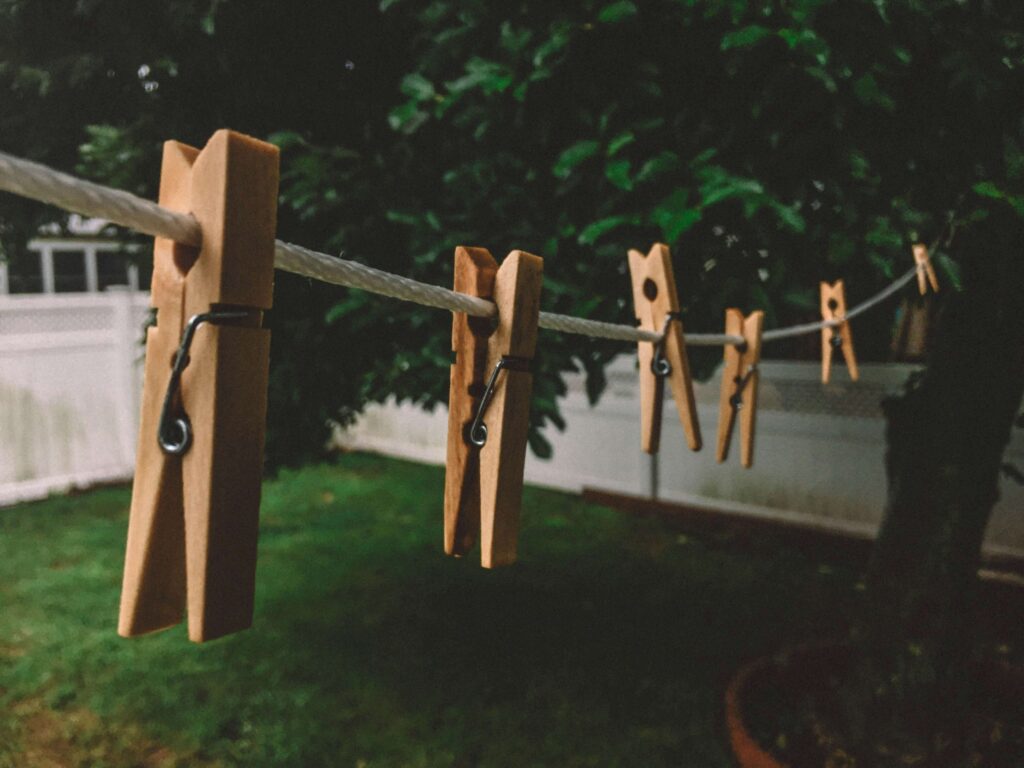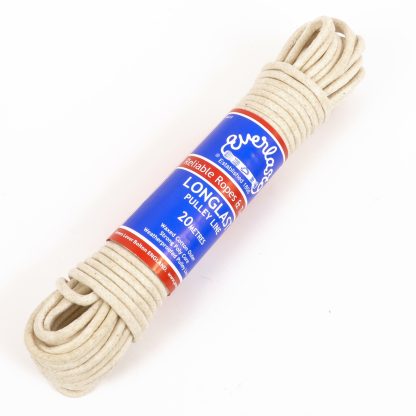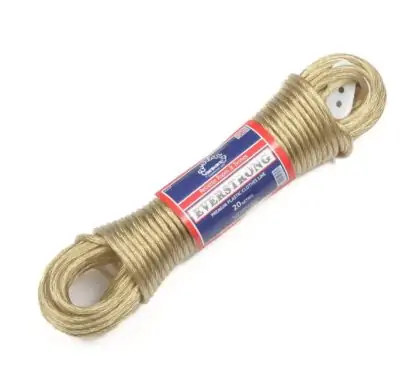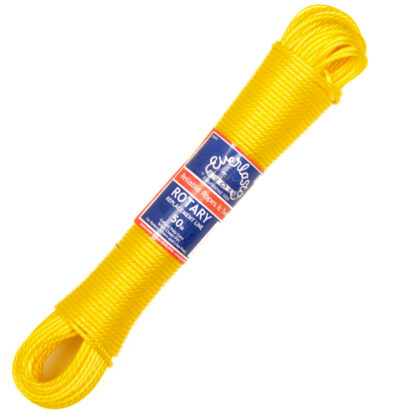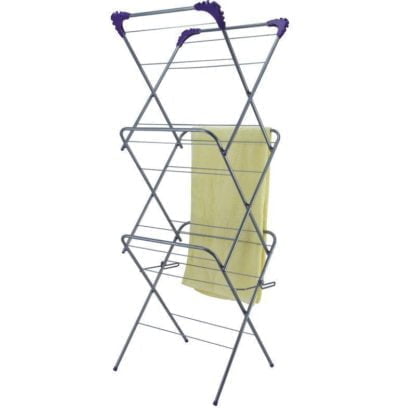
Ready to do your laundry like a pro? Drying clothes outdoors on a washing line is a time-tested, eco-friendly household task that not only saves on energy but also leaves clothes feeling fresh. However, with multiple options on the market, selecting the right washing line can be tricky.
It’s a similar argument to natural rope vs poly rope – Should you go with a natural rope washing line made from materials which are biodegradable and gentle on fabrics? Or does a durable, low-maintenance plastic washing line, built to withstand the elements, better suit your needs?
In this post, we’ll delve into both natural and plastic washing lines. From material composition and durability to environmental impact and cost, we’ll explore the key features of each line, and compare the two, to help you make an informed decision on the best washing line for your lifestyle and laundry needs.
What are natural washing lines?
Natural rope washing lines are clotheslines made from eco-friendly, biodegradable materials, such as cotton and jute. These ropes are used to hang laundry outdoors to dry naturally, making them an energy-efficient and environmentally friendly alternative to electric dryers.
Features of natural washing lines
Natural rope washing lines have several key features and benefits that make them a popular choice for eco-conscious individuals looking to dry their clothes in a more sustainable way. These include:
1. Material
Natural washing lines tend to be made from three different materials – cotton, hemp and jute. Each has their own unique features, such as:
- Cotton washing lines: Soft, flexible, and gentle on fabrics, cotton rope is commonly used for washing lines. Cotton is biodegradable, renewable, and doesn’t harm the environment.
- Jute washing lines: Whilst jute is not as soft as cotton, it is a considerably more hardwearing, water-resistant, and affordable option. However, like cotton, jute washing lines are also biodegradable, renewable, and don’t harm the environment.
2. Durability
Natural ropes used for washing lines are generally quite durable, especially those made from hemp. However, the longevity of the rope can vary depending on the material. Cotton and jute may degrade more quickly in wet or very sunny conditions, whereas ropes made from hemp or thick cotton are more resistant to fraying – making them a long-lasting option for outdoor drying.
If you’re concerned about your washing line fraying, you can explore our guide on how to prevent rope fraying for tips and tricks to keep your rope in best condition.
3. Biodegradable and eco-friendly
One of the key advantages of natural rope washing lines is their eco-friendliness. Unlike synthetic materials, natural fibres break down naturally over time without contributing to plastic waste, making them a sustainable option for drying clothes.
4. Softness and fabric care
Natural ropes, particularly cotton, are softer than other synthetic alternatives. This softness can help protect delicate fabrics like wool or silk from snags or abrasions when hanging to dry.
5. Aesthetic appeal
The rustic, natural look of ropes made from cotton, hemp, or jute is visually appealing. Many people prefer the aesthetic of a natural rope washing line in their garden or yard – especially in sustainable or country-style settings.
6. Flexibility
Natural washing lines are often flexible and can be tied, wound, or stretched between trees, poles, or walls. This versatility allows for easy setup in various locations, both outdoors and indoors. Some natural rope washing lines can also be made to be retractable, meaning you can pull them in when not in use, saving space and preventing weather damage.
7. Weight capacity
Natural rope washing lines can carry a significant load, with jute being particularly strong. Depending on the material and thickness of the rope, they can handle heavier loads of laundry, including wet towels, blankets, and larger garments.
8. Resistance to outdoor elements
Whilst natural ropes generally hold up well in outdoor conditions, they can be more susceptible to damage from constant exposure to moisture, direct sunlight, and wind compared to synthetic options. Jute, in particular, is better suited for the outdoors due to its durability.
However, if you are looking for a more hardwearing washing line with the appearance of cotton, you can purchase weatherproof cotton washing lines that come with a poly core for strength and waxed outer layer for durability.
9. Ease of installation
Setting up a natural washing line is generally simple – whether you’re using poles, hooks, or trees. It doesn’t require complicated hardware or tools, which makes this type of washing line an accessible option for most people.
10. Versatility
These washing lines are suitable for both indoor and outdoor drying. They can be used on a balcony, in a garden, or in a laundry room, and some people even use them for decorative purposes or as a creative way to organise space.
11. Cost-effective
Natural rope washing lines are less expensive than buying an electric dryer or a high-tech clothesline system, making them an affordable alternative for drying clothes without electricity.
12. Sun and fresh air drying
Clothes dried on natural washing lines benefit from sunlight and fresh air, which can help kill bacteria, reduce wrinkles, and give laundry a fresh outdoor scent.
What are plastic washing lines?
Plastic washing lines are clotheslines made from synthetic materials, such as PVC (polyvinyl chloride), nylon, or polyethylene, that are designed to hold and dry clothes outdoors. These lines are popular for their durability, resistance to outdoor elements, and relatively low cost.
Features of plastic washing lines
Plastic washing lines offer several key features and benefits that make them a popular choice for drying clothes. These include:
1. Material
Plastic washing lines can come in a variety of different synthetic materials – most usually PVC, nylon and polyethylene – each with their own benefits.
- PVC washing lines: PVC is a commonly used plastic in washing lines. It’s strong, weather-resistant, and typically has a smooth coating that makes it easy to clean.
- Nylon washing lines: Also known as nylon pulley lines, nylon is another popular choice for plastic washing lines – known for its high strength and flexibility. It is also resistant to UV rays, which helps it withstand long-term exposure to sunlight.
- Polypropylene washing lines: Polypropylene is durable and resistant to moisture, making it ideal for outdoor use. It’s also flexible and relatively inexpensive.
2. Durability
Plastic washing lines are highly durable and resistant to a variety of outdoor conditions, including rain, sunlight, and wind. They are less likely to degrade, rot, or fray compared to natural fibres, and are often coated to prevent damage from the sun’s UV rays, which makes them a long-lasting option.
3. Low maintenance
Plastic washing lines are easy to clean and don’t require much upkeep. They can simply be wiped down with a damp cloth if they get dirty and won’t harbour mould or mildew – looking as good as new in no time – unlike some natural ropes.
4. Load-bearing capacity
Many plastic washing lines, particularly nylon, have a high load-bearing capacity, making them suitable for heavy items like blankets, towels, or jeans. However, you can also opt for steelcore washing lines which are designed to be exceptionally strong.
5. Weather resistance
Plastic washing lines are designed to withstand a variety of weather conditions, making them ideal for outdoor use. They resist water and sunlight, which keeps them strong and effective for extended periods.
6. Flexibility
Plastic washing lines are often available as retractable washing lines, which can be extended when in use and retracted when not. This feature is convenient for saving space and protecting the line from the elements. However, you can very easily tighten a washing line, if it is not retractable.
7. Smooth surface
The smooth coating on plastic washing lines makes them gentle on clothes and reduces the risk of snags or fabric damage. This coating also helps to keep the line clean and free of dust and dirt that could get on your clean laundry.
8. Cost-effective
Plastic washing lines are often less expensive than high-quality natural ropes, making them an affordable choice for many households who do not want to use electric dryers.
9. Various colours and styles
Plastic washing lines come in various colours and styles, allowing you to choose one that matches your home or outdoor space. Some lines are also reinforced for added strength and durability, such as steelcore washing lines.
Comparing natural and plastic washing lines
Here’s a comparison of natural washing lines and plastic washing lines across several key aspects:
1. Material composition
Natural: Made from biodegradable materials like cotton, hemp, or jute.
Plastic: Made from synthetic materials like PVC, nylon, or polyethylene, and sometimes reinforced with metal.
2. Environmental impact
Natural: Biodegradable and eco-friendly, as they break down naturally and don’t contribute to plastic waste.
Plastic: Not biodegradable; they have a longer environmental impact as they contribute to plastic waste when discarded. However, their long lifespan means they don’t need replacing as often.
3. Durability and longevity
Natural: Less durable, especially in wet or sunny conditions. Can be prone to mould, mildew, and UV damage, causing them to fray or weaken over time.
Plastic: Highly durable and weather-resistant, with a longer lifespan – even in harsh outdoor conditions. UV-resistant options can also withstand sun exposure without becoming brittle.
4. Maintenance
Natural: Require more maintenance, such as periodic cleaning to prevent mildew. They may need to be replaced sooner due to wear from the elements, or brought inside after use.
Plastic: Low maintenance; they can be wiped clean and don’t require much upkeep. Resistant to mildew, mould, and most environmental wear, meaning they can be left outside.
5. Weather resistance
Natural: Can be susceptible to water absorption and UV damage. They can weaken and rot in wet climates, and prolonged sunlight can cause fading and deterioration.
Plastic: Strong resistance to all weather conditions, including rain, sun, and wind. They don’t absorb moisture, making them mould-resistant and suitable for year-round outdoor use.
6. Load capacity and strength
Natural: Strong, but not as suitable for heavy loads, especially if made from softer fibres like cotton or jute. Hemp is more durable but can still stretch under heavy weight.
Plastic: High load capacity, particularly in nylon or steel-reinforced plastic lines. They can hold heavier items without stretching or sagging.
7. Flexibility and installation options
Natural: Flexible in terms of setup and easy to tie between poles or trees. However, they may need frequent adjustments as they can sag or stretch.
Plastic: Also flexible, with options like retractable lines for space-saving use. They generally stay taut, needing fewer adjustments.
8. Effect on clothes
Natural: Softer on clothes, especially cotton, which is gentle and reduces the risk of snags. However, rougher materials like jute may cause minor abrasion to delicate fabrics.
Plastic: Smooth and coated, which prevents snags and is gentle on fabrics. They’re generally better for all fabric types.
9. Aesthetic appeal
Natural: Rustic, natural appearance that can blend well with outdoor gardens or eco-friendly home settings.
Plastic: Available in various colours and styles, but may lack the rustic, natural aesthetic that some people prefer.
10. Cost
Natural: Generally affordable, though high-quality hemp ropes can be more expensive. However, they may need to be replaced more often, which can add to the overall cost.
Plastic: Often inexpensive and long-lasting, making them cost-effective over time.
Key considerations when choosing your washing line
Natural washing lines are ideal for those prioritising eco-friendliness and a natural look, but they require more maintenance and are less durable in harsh conditions. Plastic washing lines, on the other hand, offer greater durability, low maintenance, and a higher load capacity, though they aren’t biodegradable.
Your choice will depend on your priorities: sustainability and aesthetics with natural ropes, or durability and ease of use with plastic. Cost may also come into play when making your decision, though this can easily be balanced between the two options.
When it comes to washing lines, we’re the experts. Yes, really. James Lever was the first to introduce PVC washing lines to the UK in the 60s, and the Everlasto range has remained the UK brand leader ever since. To find out more about our product ranges, contact our helpful team today, or explore more resources on our blog.
